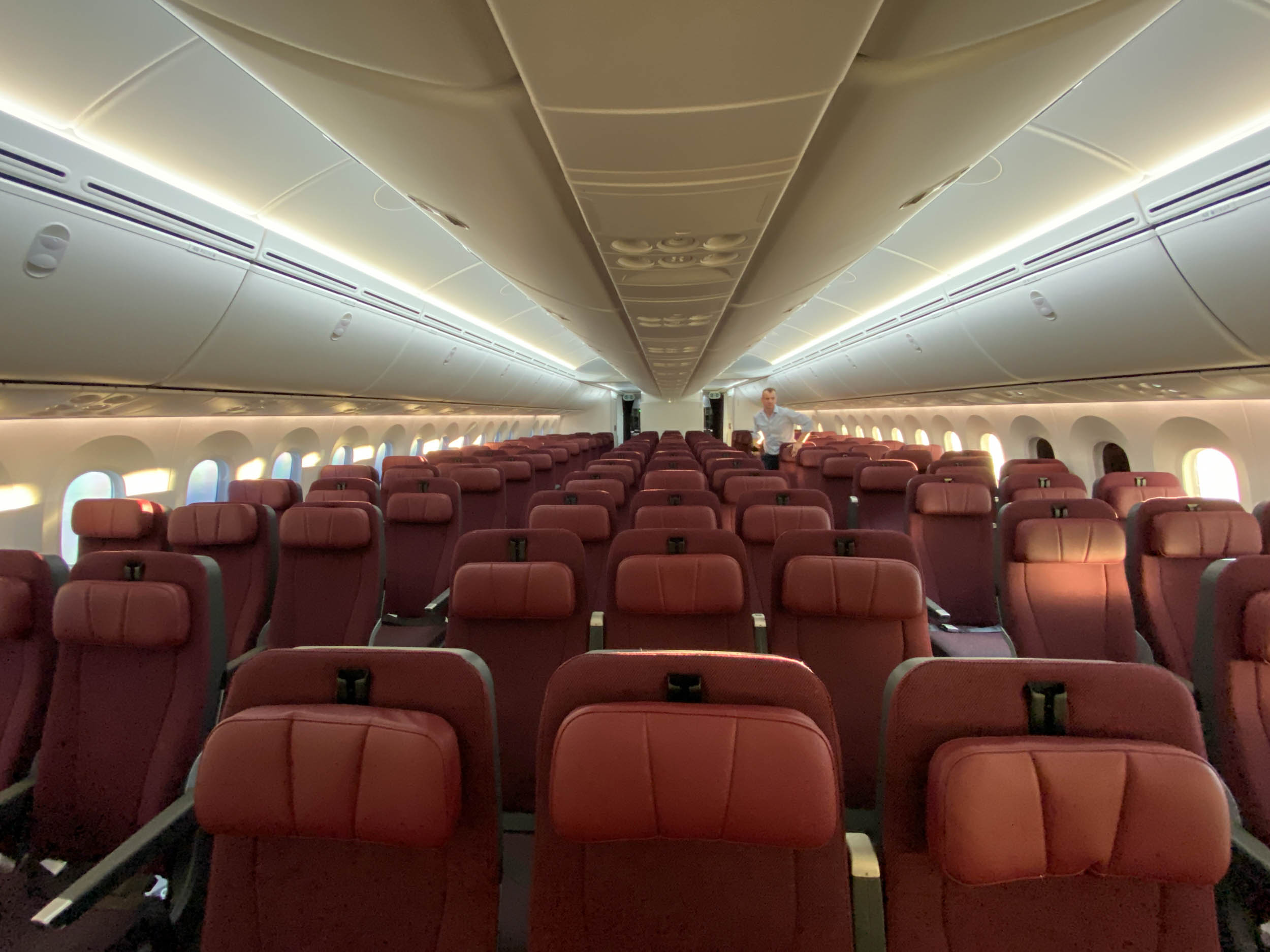- Fears of coronavirus are prompting passengers to rethink travel, with most airlines offering waivers for those with tickets affected regions.
- Air travel is largely responsible for the spread of the disease to countries beyond its origin.
- Protective measures when flying can help keep passengers safe on board an aircraft.
- Visit Business Insider’s homepage for more stories.
While the expansion of air travel has made the world a smaller place, it has also facilitated the spread of disease, as seen with novel coronavirus cases appearing in the US.
The situation as complicated by the fact that travelers can show no or few symptoms, board a plane, and be almost anywhere in the world within hours.
It’s not only the coronavirus that can spread this way, as passengers with the common cold or flu can board a plane and potentially spread their illness to surrounding passengers.
When stuck on a plane for an extended amount of time, it’s not as simple as to move to the other side as seat assignments are fixed. Flyers can potentially be stuck sitting next to an ill passenger for an entire flight.
All hope isn't lost for health-conscious travelers, however, as there are ways to ward off unwanted and potentially dangerous germs.
Here's what flyers can go on their next flight to avoid germs.
Before even getting to the airport, flyers should ensure they have all their vaccines for travel.

Certain destinations require vaccinations or medicines for diseases including malaria and typhoid, but even a flu shot can help your body defend itself, according to Dr. Scott Weisenberg, director of travel medicine at NYU Langone Health.
Being properly vaccinated will help prevent catching an infectious disease that would weaken an immune system and potentially lead to the contraction of additional diseases, such as coronavirus.
All doctors agree that handwashing with soap and water is a great preventative measure against illness.

"Wash your hands and avoid touching your face and eyes," Dr. Salvatore Pardo, chair of emergency medicine Northwell Health's Long Island Jewish Valley Stream Hospital, said.
The practice is an easy way to prevent the germs that our hands touch in communal areas from reaching our mucous membranes. Hand sanitizer is also a valuable alternative, with travel-sized containers that meet the TSA's liquid requirement available for purchase.
Passengers should also take it upon themselves to ensure a germ-free seat by bringing disinfecting wipes on their next flight, says Dr. Pardo.

Airlines do employ cleaners to ensure aircraft are cleaned but a flight delay or the pressure placed upon airport staff to ensure flights depart on time means that aircraft sometimes don't receive all the cleaning they require.
"If you can bring a disinfectant wipe on board to wipe your seating area around you as you sit down, do so," Dr. Pardo said.
Passengers bringing their own wipes should ensure that the parts of the seat that are most susceptible to being touched are covered. The seat cover, tray table, armrest, seat-back pocket, headrest, seat-back screen, overhead air vent, in-flight entertainment screen, and even window shade should all be wiped.
Another commonsense measure to avoid potential germs is to avoid people altogether

"Stay away from people who are coughing or exhibiting any other signs of a respiratory illness," Dr. Bernard Camins, medical director for infection prevention at the Mount Sinai Health System, said.
But while the majority of flyers can't easily charter private jets, they can choose seats away from other flyers.
"For the flu, close contact is considered three feet. For the novel coronavirus, close contact is considered six feet," according to Dr. Camins.
The aisle is frequently traversed by bathroom-goers, flight attendants, and just plain potential germ carriers, meaning its best to avoid for minimum exposure. The window seat on most airliners is often the furthest from the aisle, giving flyers a modicum of protection from the germ highway that extends the length of the aircraft.
One way to avoid people is to pick a seat with the adjacent seat open or get an entire row to yourself.

"The main risk is people in the rows [and seats] around you," Dr. Pardo said.
If on a moderately full flight, being diligent about seat selection at check-in and in the hours leading up to the flight is one way to aid a passenger's chances of having an empty seat next to them. But the best way is to ask your gate agent when you get to your gate.
The seat map for a flight tends to solidify as boarding nears as that is when the airline will assess who will actually be on the flight. In the time between check-in and boarding, a seat map may change as passengers miss check-in windows, elite flyers get upgraded, and travel plans change based on delays or cancellations.
Asking the gate agent whether or not anything has opened up just may yield some better and more up-to-date results than checking the seat map at the check-in kiosk when you arrived at the airport. The seat map isn't 100% confirmed, however, until the boarding door is closed.
Airplane lavatories are among the most frequented areas of an airplane, making them an ideal place to avoid.

"Avoid high contact areas such as the bathrooms," Dr. Weisenberg said.
With everything from the doorknobs to the flush buttons being touched by multiple passengers on a given flight, the potential for coming into contact with harmful pathogens is high.
Dr. Pardo also recommends avoiding areas of airplanes touched by the greatest number of people and the lavatory ranks among the highest on that list.
Should using the lavatory be an absolute necessity, wash your hands before exiting and consider also using hand sanitizer when you get back to your seat.
The N95 is the best mask to use for protection against pathogens.

"Currently the N95 masks are the highest level masks which protect against most pathogens," Dr. Pardo said.
But that doesn't mean they should always be worn.
"Unless you are in a healthcare setting, a face mask should only be worn by someone who has symptoms of a respiratory illness or if you will be in close contact with someone with the novel coronavirus infection," Dr. Camins said.
Since airplanes require being in close contact with other people and coronavirus has a two to 14-day incubation period during which it can be transmitted, however, wearing a mask wouldn't be completely useless, according to Dr. Pardo.
"Plain surgical masks are likely to be effective due to [coronavirus] likely transmitted by droplet," Dr. Pardo said.
The most common gripe with air travel is the so-called "recycled air" flowing through the cabin, but circulated air can actually do more good than harm.

"Most, if not all of modern commercial planes have HEPA filters that will filter the air of respiratory droplets," Dr. Camins said.
Most aircraft have air vents above each seat to dispense this clean air directly to passengers. There's research that the air from these vents, when forced directly down on the seat occupant, can insulate from lingering, unfiltered air, The Points Guy found.
The air may be dry, however, so flyers should ensure they're compensating by drinking water.
Drinking more water when flying as opposed to alcoholic or caffeinated beverages helps keep your defenses up against potential germs.

"Dehydration can contribute [to] a weak immune system. Don't try and hydrate with caffeinated or alcoholic beverages ... those will contribute to dehydration," Dr. Pardo said.
Ordering water over a dehydrating drink, including alcoholic beverages and non-decaf coffee and tea, also go a long way in terms of maintaining a strong immune system when flying and preventing valuable mucous membranes from drying up.
Newer aircraft should be chosen over older aircraft if a particular trip allows for the option.

"The low humidity [of an airplane cabin] will dry out your mucous membranes (eyes, nose, mouth), which will make it less effective in blocking the virus," Dr. Pardo said.
Standard airliners have cabin altitude pressure of around 8,000 feet where the humidity levels are low. Ultra-modern aircraft such as the Boeing 787 Dreamliner and Airbus A350 XWB feature technology that lowers the cabin altitude pressure of an aircraft to around 6,000 feet, allowing for higher humidity levels.
These aircraft are mostly found on long-haul routes but should be favored over older aircraft to help give the body a better chance at fighting off potential illnesses.
Our bodies can also still fight illnesses while we're sleeping.

Travelers shouldn't avoid sleeping on airplanes for fear that the immune system isn't working as hard to fight potential illnesses.
"Sleep is good for your overall health ... I wouldn't discourage people from sleeping," Dr. Weisenberg said.
The body works just as hard to fight illnesses even when we're asleep, but precautions should still be taken if deciding to sleep near someone who is coughing or sneezing.
Relaxation is just as important as preparation.

The stress of travel can increase the chances of getting an illness, according to Dr. Weisenberg. While there's only so much we can do to externally protect ourselves from illness, one of the most important aspects of protection is internally in our own heads.
That may be easier said than done, however.

